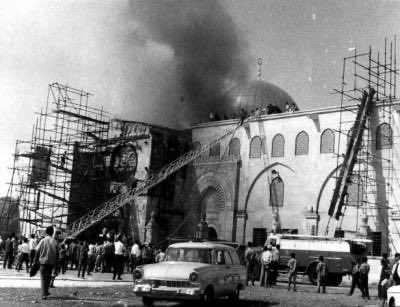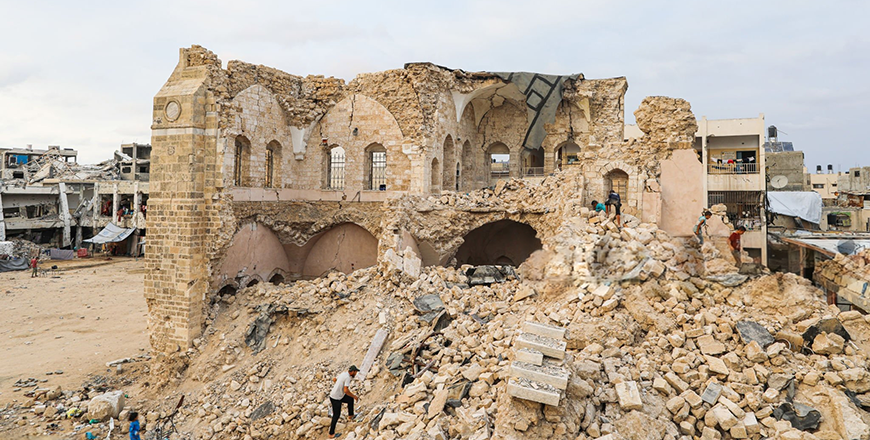
As we remember the 55th anniversary of the burning of the blessed Al-Aqsa Mosque, the threats targeting the Muslim holy places seem to be more dangerous than ever. These threats are growing daily amidst the Israeli genocide in the Gaza Strip, ongoing since 7 October, 2023 according to the Palestine Information Center.
On 21 August, 1969, the Zionists burned the Al-Aqsa Mosque.
The Zionist Jewish terrorist Dennis Michael Rohan deliberately set the Mosque on fire that devoured large and important parts of its landmarks, most notably the pulpit of Salah al-Din al-Ayyubi.
The burned out area extended to more than a third of its total space, as more than 1,500 square meters were scorched.
The area of Al-Aqsa Mosque is 144 dunums, including the front Qibli Mosque, Dome of the Rock Mosque, Marwani prayer hall, Bab al-Rahma prayer hall, as well as the benches, arcades, corridors, wells, external gates and everything surrounding Al-Aqsa from the walls and external walls, including the Buraq Wall.
Significant damage and impunity
The fire caused significant damage to the construction of the Al-Aqsa Mosque, its columns, arches, and ancient decorations. The roof of the mosque fell to the ground as a result of the fire, and two main columns fell with the arch supporting the dome.
Parts of the decorated inner dome, mihrab, and the southern walls were also damaged, and 48 of the mosque’s windows made of gypsum and stained glass were shattered. The carpets, many of the decorations, and Quranic verses were burned.
Simultaneously with the fire, the occupation forces cut off water to the Qibli Mosque and its surroundings, and were slow to send fire engines, which prompted the Palestinians to put out the fire with their clothes and water from the wells of Al-Aqsa Mosque.
The Israeli occupation authorities claimed that the fire was caused by an electrical short circuit, but Arab engineers proved that it was caused by an act of arson, which forced the occupation to arrest Rohan and bring him to trial. It was not long before he claimed that he was mentally disturbed and then he was released.
A year after the fire, restoration work began under the supervision of the Islamic Endowments Department in Jerusalem, affiliated with Jordan’s Ministry of Endowments.
The restoration work continued until 1986, when the bricks were removed and prayers resumed in the southern part of the mosque. An iron pulpit replaced that of the Nour al-Din Zanqi pulpit in 2006.
The burned area of the Al-Aqsa Mosque amounted to more than a third of its total area, with more than 1,500 square meters burned.
Raging fires
Since 2003, the Israeli occupation authorities have allowed settlers to storm the Al-Aqsa Mosque through the Mughrabi Gate in the western wall of the mosque.
Since then, thousands of Zionist settlers have stormed the mosque every day except Friday and Saturday, amidst provocations against worshipers and mosque guards.
Silence and isolation
The Europeans for Jerusalem Foundation warned of the dangers targeting the Al-Aqsa Mosque amid the Israeli genocide in the Gaza Strip.
The foundation said in a statement on the occasion of the 55th anniversary of the burning of Al-Aqsa Mosque: The anniversary comes amid more dangerous incidents affecting the mosque and seeking to impose a new fait accompli on it and divide it temporally and spatially with complete silence and Israeli monopoly over the crime of genocide committed against the Palestinians in the Gaza Strip.
It pointed out that days before the anniversary, the extremist Israeli Minister of National Security Itamar Ben-Gvir and the Minister of Negev and Galilee Affairs Yitzhak Wasserlauf participated in storming Al-Aqsa Mosque, which now witnesses the performance of Jewish extremists’ prayers and epic prostration in the mosque with the approval of the Israeli police, which until recently prevented this.
Last year, Hebrew newspapers revealed a plan by the Zionist Knesset member from the Likud Party, Amit Halevy, aimed at dividing Al-Aqsa Mosque.
His plan stipulates controlling the Dome of the Rock and turning it into a place of worship for Jews, in addition to the northern area of the mosque’s courtyards, while Muslims will be allowed to pray in the southern prayer halls and their facilities only.
Halevy claimed that the reason for focusing on controlling the Dome of the Rock is that “the First and Second Temples are located under it.”
The plan also includes allowing Jews to storm Al-Aqsa through all gates and not just Bab Al-Maghariba as is the case today, in addition to canceling Jordanian sponsorship of Al-Aqsa Mosque and canceling any status for Jordan over the holy places.
The occupying state is working through several paths to Judaize Al-Aqsa Mosque and impose new facts on it, noting that more than 125 attacks on the mosque have been documented over the past seven months and that 28,653 settlers have participated in storming the mosque since the beginning of the year until the end of last July.
The anniversary of the burning of Al-Aqsa Mosque is an occasion to remind us of the extent of the violations committed by the Israeli authorities against the mosque and the entire city of Jerusalem, whose indigenous residents face the most heinous forms of racial discrimination in modern times, according to Europeans for Jerusalem Foundation.
It stated that the Al-Aqsa Mosque is a global cultural heritage that requires global efforts to protect it and rid it of the brutal occupation that seeks to falsify history and Islamic cultural identity.
It indicated in light of the growing dangers targeting the mosque, which remain a frequent ignition fuse, especially with the presence of this extremist government whose ministers openly call for imposing a new fait accompli in the mosque in violation of the historical and legal right recognized by the United Nations, the international community must take urgent action to stop the Israeli violations against the mosque, its worshipers, and all Islamic and Christian sanctities in the city of Jerusalem.

 (@PressTV)
(@PressTV)  (@ameer_abdoh)
(@ameer_abdoh) 






